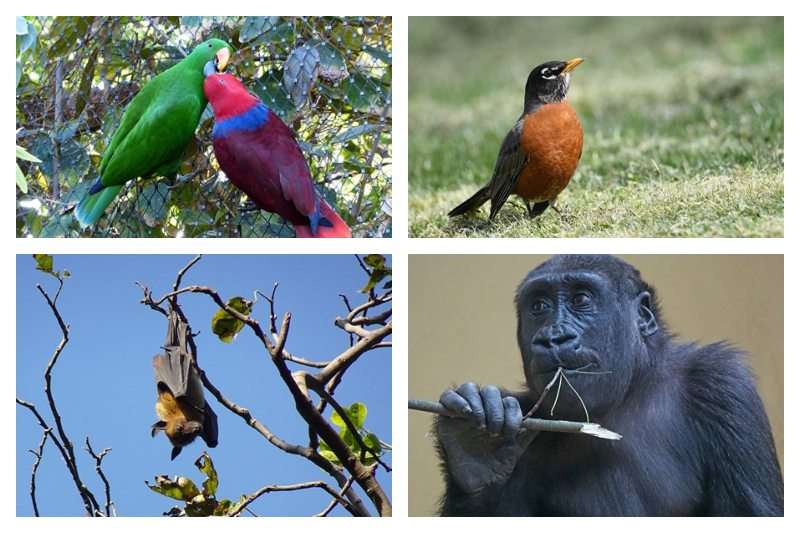Food serves to be the fuel for our everyday activities. Based on what they eat, animals can be grouped into three main categories: Herbivores, omnivores, and carnivores.
Frugivores are a sub-class of herbivores and comprise animals that depend on fruits for their survival. In today’s article, we are going to talk about 20+ Animals that Eat Fruits or, in simple terms, Frugivore Animals.
In addition, we will also mention an interesting fact about each of them. So, without any further delay, let’s begin.
Common Animals that Eat Fruits
1) Toco Toucans
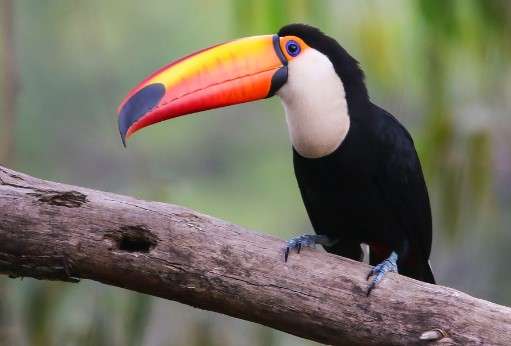
| Scientific Name | Ramphastos toco |
| Size | 60 to 63 cm |
| Life Span | 12 to 20 years |
| Geographic Location | South America |
Toco toucans reside in the tropics, with berries and fruits as a mainstay of their diet. The Toco toucan mostly consumes figs, oranges, guavas, peppers, and various other uncommon tropical fruits.
With their beaks clasped around the food, Toco toucans throw it toward their throat. They are opportunistic in their fruit and plant intake and will consume whatever is in season. The average life span of Toco Toucans is up to 20 years.
Interesting fact: Tocos are the largest Toucans in the world.
2) Orangutans

| Scientific Name | Pongo sp. |
| Size | 150 to 180 cm |
| Life Span | 35 to 45 years |
| Geographic Location | Indonesia and Malaysia |
Orangutans have a diet that comprises nearly 90% fruits spread over more than 400 different kinds of plants. Durians, a fragrant and spiny fruit, are a favorite fruit of orangutans.
To break into such fruits, orangutans employ a range of tools as well as their strong jaws. Orangutans can memorize the locations of transient food sources, monitor seasonal shifts in fruiting peaks, and recognize animal behavioral cues to locate fruiting trees.
Interesting fact: They are the heaviest tree-dwelling animals in the world.
3) Indian Flying-foxes
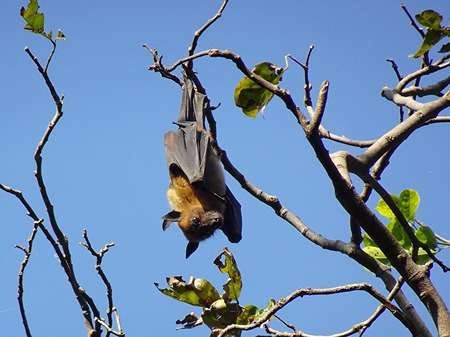
| Scientific Name | Pteropus medius |
| Size | 15.5 to 22.0 cm |
| Life Span | up to 31 years |
| Geographic Location | Indian subcontinent |
Indian Flying Foxes is one of the world’s biggest bats. This bat is nocturnal and mostly consumes nectar and ripe fruits like mangoes and bananas.
The Indian flying fox is a frugivore or nectarivore, which means they consume fruits or ingest floral nectar. It searches for ripe fruit at dusk.
It consumes any fruit that is available and is an opportunistic feeder. Seasonally, their food varies, with a larger reliance on mango fruits for moisture in spring and autumn.
Interesting fact: Flying Foxes carry their babies while being airborne.
4) Hammer-Headed Bat
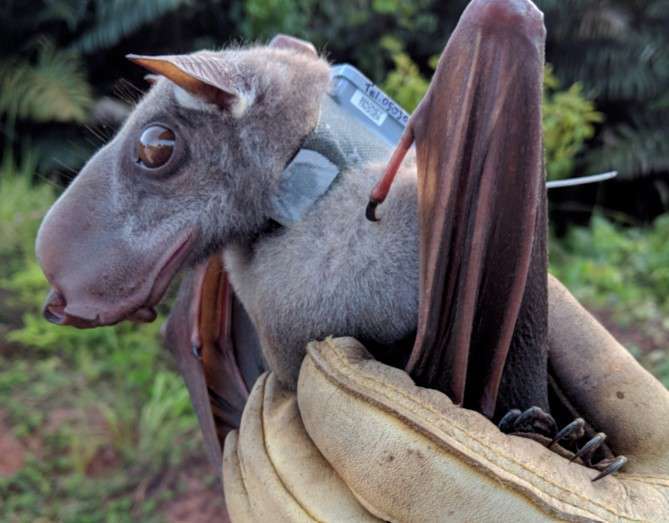
| Scientific Name | Hypsignathus monstrosus |
| Size | 90 to 97 cm |
| Life Span | up to 30 years |
| Geographic Location | Africa |
The fourth animal on this list of Animals that eat Fruits or Frugivore Animals we have Hammer-headed bat. They are strictly fruit eaters, and figs comprise a major share of their diet.
However, they also feed on mangoes, guavas, bananas, etc. Foraging strategies differ between males and females, as females depend on a fixed route with food sources, while males are more explorers, looking for areas with nutrient-rich fruits.
They either feed on the spot or take it to some other location, where they chew and eat the pulp and juice and spit out the rest.
Interesting fact: They have been labeled as the world’s ugliest creatures.
5) Western Lowland Gorillas
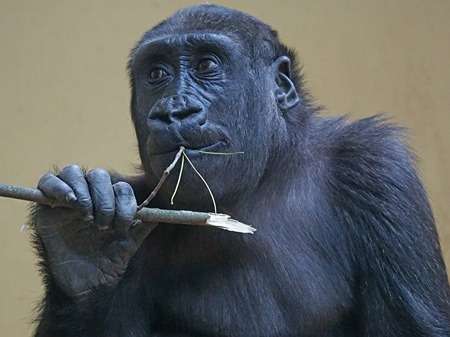
| Scientific Name | Gorilla gorilla gorilla |
| Size | 137-182 cm |
| Life Span | 30 to 40 years |
| Geographic Location | Central Africa |
Western Lowland Gorillas come next on this list of animals that eat fruits and frugivorous animals. Although gorillas are enormous, they are vegetarians.
Fruit is a common food source for gorillas during the rainy season. Although there is a decline in the consumption of fleshy fruits during the dry season, people still eat other types of fruits.
When preferred fruit species fail to produce significant yield, the variety of fruits that they consume increases sharply.
Interesting fact: They are the largest primates in the world.
6) Hazel Dormouse
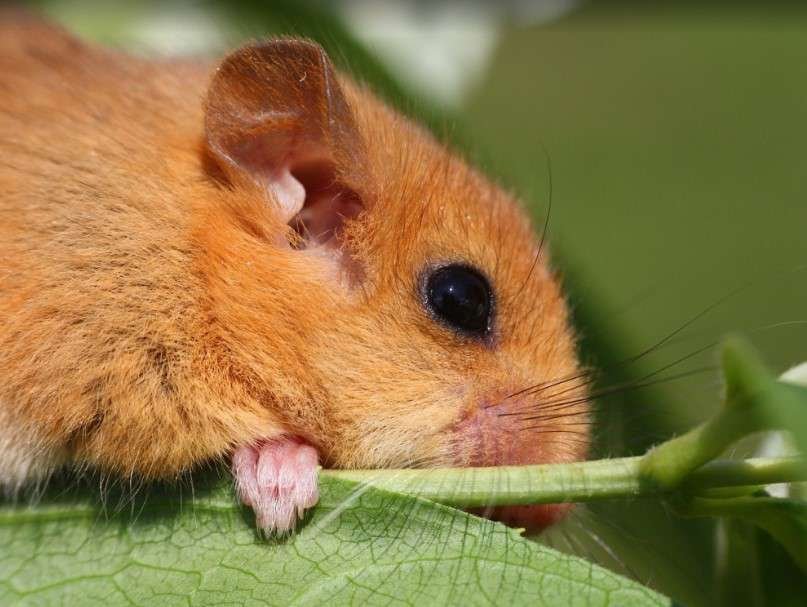
| Scientific Name | Muscardinus avellanarius |
| Size | 10-16 cm |
| Life Span | 4-5 years |
| Geographic Location | Europe and Asia Minor |
The hazel dormouse is primarily distributed in Asia Minor and Northern Europe. It is a nocturnal species and is mainly arboreal. To avoid danger, due to its small size, it will even make lengthy diversions through the branches.
The omnivorous dormouse eats insects, nectar, pollen, flower buds, and leaf and flower buds. Berries, nuts, and other fruits are also food sources for it. Blackthorn fruit, blackberries, buckthorn, yew fruit, raspberries, and dewberries are a few kinds of fruits that the dormouse eats.
Interesting fact: Though it has the word hazel in its name, the Hazel dormouse takes nearly 20 minutes to crack open a hazelnut.
7) Cassowaries

| Scientific Name | Casuarius sp. |
| Size | 170-182 cm |
| Life Span | up to 60 years |
| Geographic Location | New Guinea, Indonesia, Northern Australia |
Cassowaries enjoy eating plants, though they will occasionally capture tiny animals, insects, and mushrooms. In their diet, scientists have found over 240 different plants. Cassowaries eat a variety of foods, but fruits predominate their diet, being almost 90%.
Fruit that has fallen on the ground is mostly what they eat. Because they spread the seeds of numerous plants, cassowaries are regarded as keystone species. More than 100 plants are thought to be dependent on these birds.
Interesting fact: Cassowaries deliver one of the most powerful kicks in the world.
8) Kinkajou
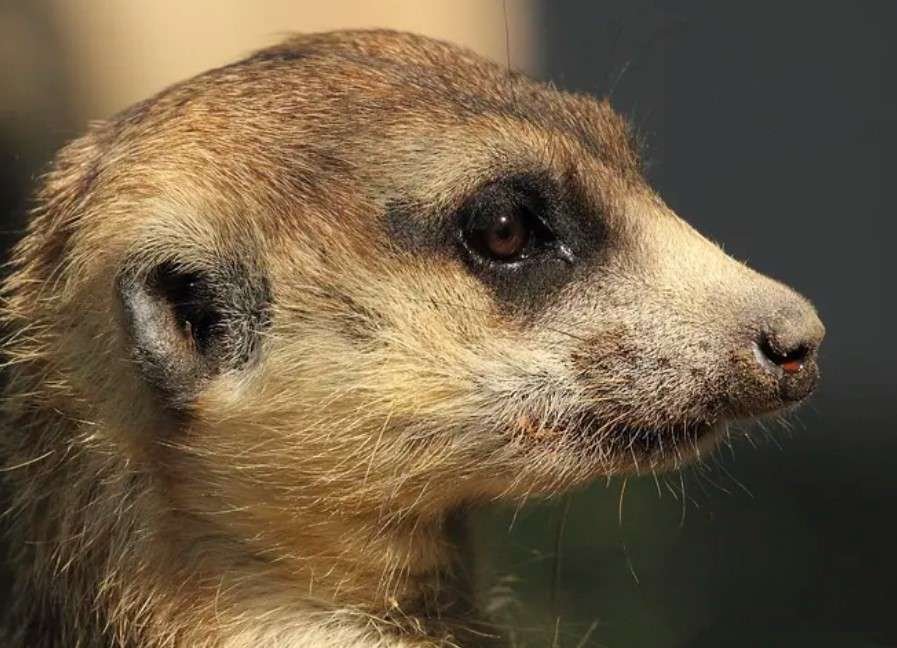
| Scientific Name | Potos flavus |
| Size | 82 to 133 cm |
| Life Span | 20-23 years |
| Geographic Location | Central and Southern Africa |
Kinkajous are opportunistic feeders. They are first and foremost frugivores, but they occasionally take a dig at proteins like eggs, hatchlings, insects, etc.
Kinkajous diet ranges over quite a wide spectrum and includes bananas, apples, watermelons, peaches, pears, guava, grapes, blueberries, blackberry, cheery, dragon fruit, raspberry, and the list goes on. Apart from the fruit, they also love honeydew and nectar from fruit trees.
Interesting fact: The scientific name of the kinkajou stands for “sweet tooth.”
9) African Civet Cats
| Scientific Name | Civettictis civetta |
| Size | 67 to 84 cm |
| Life Span | 15-20 years |
| Geographic Location | Central and Southern Africa |
The tropical rainforests of South and South-Eastern Asia are the principal habitat for civet cats. The deep canopy of the jungles is perfect for their way of existence because they are a slow-moving arboreal species that rarely descends to the forest floor.
Bearcats are omnivores and consume fruits, fish, invertebrates like earthworms, and small mammals and birds. Figs are the fruit that they eat the most frequently. However, apples, grapes, and plantains have all been fed to captive civet cats.
Interesting fact: The African Civet Cat may release as much as 4 kg of musk in a day.
10) Red-foot Tortoise
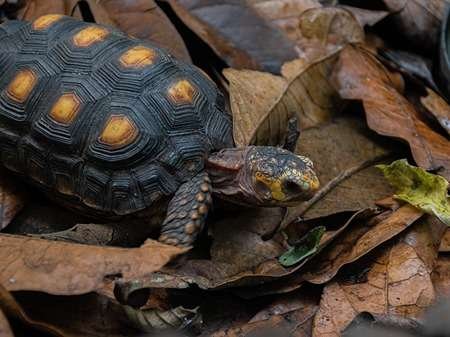
| Scientific Name | Chelonoidis carbonarius |
| Size | 28 to 34 cm |
| Life Span | 50+ years |
| Geographic Location | Panama and South America |
Red-foot tortoises have become quite popular in the tortoise-keeping hobby. Red-foots are omnivorous creatures, but fruits and vegetables constitute quite a large portion of their diet.
Since red-foots are tropical animals, therefore, they mostly prefer tropical fruits like papaya, mangoes, watermelons, strawberries, blueberries, tomatoes, apples, and even cactus fruits.
Interesting fact: Red-foot tortoises are one of the most sought-after pet tortoises in the world.
11) Bohemian Waxwing
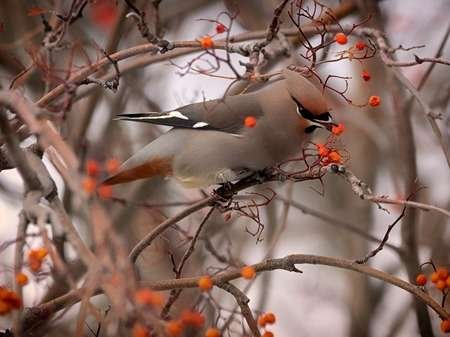
| Scientific Name | Bombycilla garrulus |
| Size | 32 to 35.5 cm |
| Life Span | 4-5 years |
| Geographic Location | Eurasia and North America |
Fruits dominate a waxwings diet. Fruits are often taken whole and are typically gathered from trees or the ground.
Their diet is predominated by cotoneaster, juniper, haws, rose hips, apples, Vaccinium, and Rubus species, as well as Canada buffaloberry, which are significant components of their diet during the summer.
When available, they love to consume rowan berries. Each waxwing may consume several hundred berries each day.
Fruit must be consumed in large quantities because it is high in sugar but low in other nutrients. Large livers of bohemian waxwings aid in turning sugar into energy and have an efficient ethanol metabolism.
Interesting fact: They have an excellent affinity towards berries and can find them almost everywhere, much like a GPS tracker.
12) Jambu fruit dove
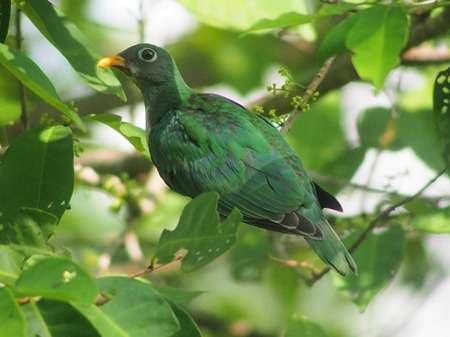
| Scientific Name | Ptilinopus jambu |
| Size | 23 to 27 cm |
| Life Span | 1-2 years |
| Geographic Location | Malay Peninsula |
Next up on this list of animals that eat fruits or frugivore animals, we have the Jambu Fruit Dove. As the name suggests, the Jambu Fruit Dove is a fruit eater.
It typically appears alone or in pairs, although a big flock may congregate when feeding at a fruit tree. It consumes fruit straight off the tree or from the ground if other frugivores, like hornbills or monkeys, have dropped it there.
Interesting fact: Jambu fruit doves are one of the most colorful birds in the world.
13) Great Hornbills
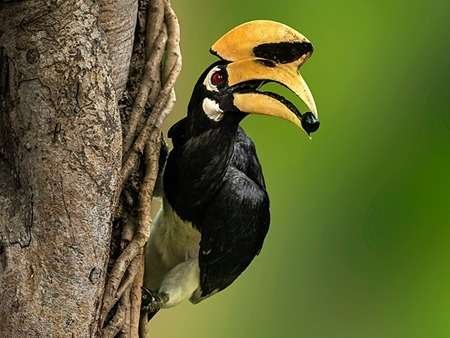
| Scientific Name | Buceros bicornis |
| Size | 95 to 120 cm |
| Life Span | 35-40 years |
| Geographic Location | Indian Subcontinent and Southeast Asia |
Great Hornbills are primarily frugivores. Fruit, particularly various varieties of figs, makes up the majority of their diet. Great hornbills can visit numerous fruiting trees and fly considerable distances in a single day in search of food.
Hornbills can consume figs at a rate of roughly 200 during each meal. With the tips of their beaks, they carefully pluck the figs. These are finished in pieces rather than being swallowed whole.
Interesting fact: Many Northeast Indian tribes, especially in Nagaland and the Dayak Tribe of Borneo, consider Hornbills to be a spirit of God.
14) Eclectus parrots
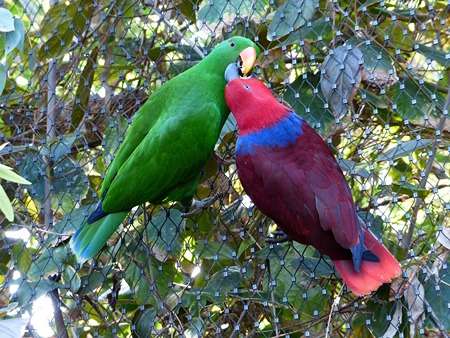
| Scientific Name | Eclectus roratus |
| Size | 43 to 45 cm |
| Life Span | 20-50 years |
| Geographic Location | Northern Australia, Solomon Islands, New Guinea etc. |
Eclectus parrots are one of the most beautiful parrots in the world. They are mostly frugivores, and their diet ranges over a variety of fruits like bananas, watermelons, berries, pears, etc.
Tropical, less sugary fruits are mostly preferred. Pet Eclectus parrots are quite popular pets and are given a diet that consists of soft foods like fruits, vegetables, grains, and sprouts.
Interesting fact: Eclectus Parrots fly as far as 20 km to find food.
15) Asian koel

| Scientific Name | Eudynamys scolopaceus |
| Size | 39 to 46 cm |
| Life Span | 10-14 years |
| Geographic Location | India, Bangladesh, Pakistan, Sri Lanka |
The Asian Koel, also known as the bearer of the spring season, is a sizeable omnivorous bird. They primarily feed on fruits and berries of native trees and shrubs.
Asian Koel mainly forages on Peepal fruits, Banyan fruits, Plums, Mulberry, Fishtail Plum nuts, Ivy gourd, and many others. Apart from fruits, they also feed on small invertebrates like caterpillars, snails, and bugs and smaller vertebrates like lizards.
Interesting fact: Asian Koel lay their eggs in crows’ nests, which raise the hatchlings as their own.
16) Grey-bellied Night Monkeys
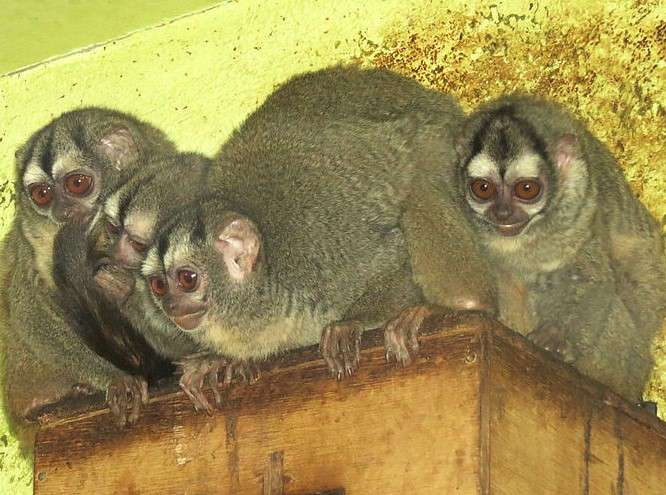
| Scientific Name | Aotus lemurinus |
| Size | 47 to 53 cm |
| Life Span | 20-40 years |
| Geographic Location | North-western region of South America |
The next animal in this list of Animals that eat Fruits or Frugivore Animals is the Grey Bellied Owl Monkeys. Primarily a frugivore, they feed on quite a diverse variety of fruits.
They feed on small but ripe fruits, along with green leaves and nectar. When fruit supply is scarce, Grey Bellied Night Monkeys may resort to insects and even small birds.
Interesting fact: Their two large eyes give them the name “Owl Monkeys.”
17) Rhesus Monkey
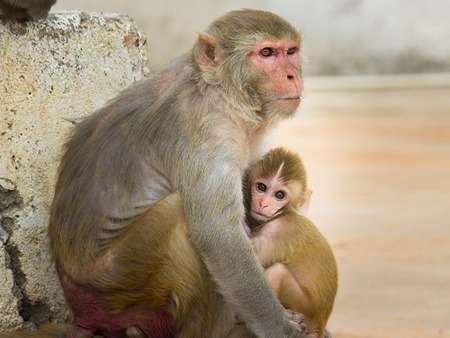
| Scientific Name | Macaca mulatta |
| Size | 47 to 53 cm |
| Life Span | 20-40 years |
| Geographic Location | South and South-East Asia |
The Rhesus Macaque is the most common monkey species that we often encounter. Living close to human settlements, most of their diet comes from humans. They mostly eat plant matter, which largely comprises fruits.
Rhesus monkeys mainly eat bananas, apples, watermelons, grapefruits, and several others. They may procure it naturally from the wild or steal from any shop or house.
Interesting fact: The Rhesus Monkeys, especially in India, often engage in death fights with the local stray dogs.
18) Black Pacu
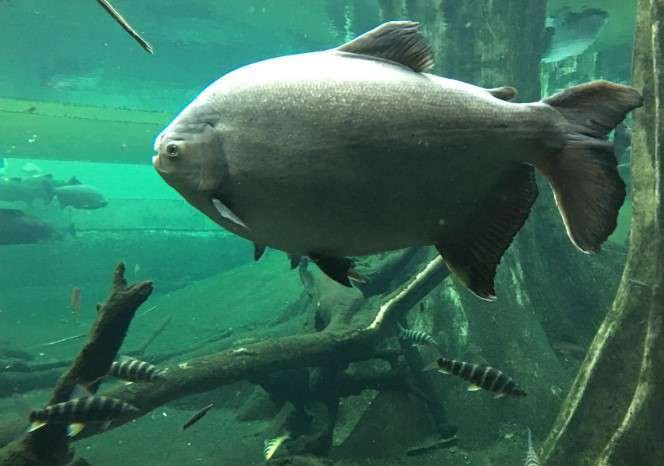
| Scientific Name | Colossoma macropomum |
| Size | 80 to 90 cm |
| Life Span | 12-15 years |
| Geographic Location | Amazon Basins in South America |
The Black Pacu, though a relative of the piranhas, is an omnivorous species, with fruits and nuts comprising their primary diet. However, they occasionally feed on insects and smaller fish.
Black Pacus feed on grapes, bananas, sweet potato, papayas, grains, seeds, and other plant matter. They are an Amazonian species and live within floating vegetation.
Interesting fact: Despite its resemblance to the piranha, it is primarily a herbivore.
19) Parakeet

| Scientific Name | Melopsittacus undulatus |
| Size | 18 to 45 cm |
| Life Span | 5-30 years |
| Geographic Location | Worldwide |
In the 19th position of this list of Animals that eat fruits or frugivore animals, we have Parakeets. One of the most commonly kept animals as pets, Parakeets have a diet that mainly comprises fruits, seeds, and grains.
In fruits, parakeets primarily feed on apples, apricots, cherries, bananas, grapefruits, grapes, etc. A variety of fruits helps the birds to meet their nutritional requirements. Apart from fruits, parakeets also feed on vegetables.
Interesting fact: Budgerigars (a species of parakeet) is the third most commonly kept pet in the world.
20) American Robin
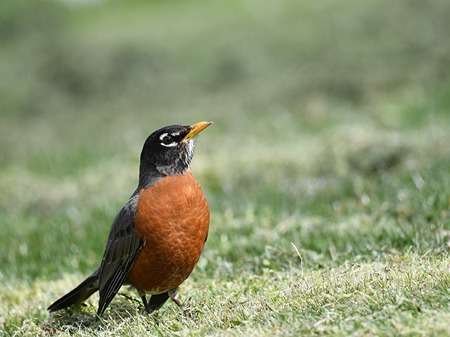
| Scientific Name | Turdus migratorius |
| Size | 23 to 28 cm |
| Life Span | 1-2 years |
| Geographic Location | south of Canada |
The 20th animal on this list of animals that eat fruits or frugivores animals is the American Robin. The American is not a typical fruit eater, as it has a mixed diet comprising both insects and fruits.
However, fruits occupy a major share of their diet, nearly 60%, while insects make up the remaining 40 %. Their split diet helps them to adjust to the changing seasons, depending on the food availability.
In the winter, fruits and berries are their primary food, while summers have protein-rich meals like insects and other invertebrates.
Interesting fact: American Robins often engage in death fights to protect their territory.
21) White-Throated Sparrows
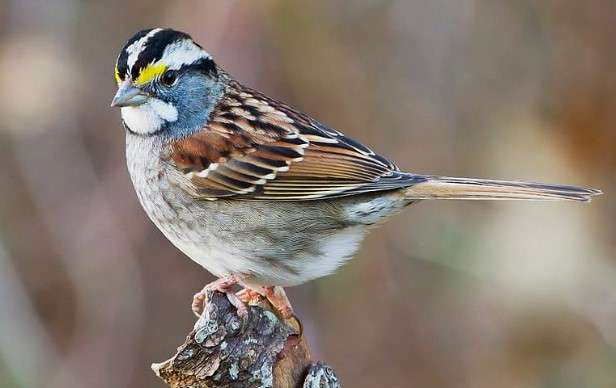
| Scientific Name | Zonotrichia albicollis |
| Size | 15 to 19 cm |
| Life Span | 8-10 years |
| Geographic Location | Central Canada and New England |
Another beautiful small bird on the list is White-Throated Sparrow. These small birds mainly feed on seeds and berries and also attract to various bird feeders.
These birds have white bellies and brown furs with black and white stripes all over their head. They are commonly found in Canada and New England.
Here, we conclude this article, 20+ Animals that Eat Fruits (Pictures & Facts) | Frugivore Animals. Stay tuned for many more such interesting articles in the future.
Also Read:

A zoology student turned writer. Nature has always been a magnet to me, and to unearth some of its secrets through my articles is my prime intention. If not engaging myself with nature and anime content, you can always find me going through some Bengali classics or filling the air with some soulful Tabla beats. An artist, trying to throw some colors to my blank canvas of life.
